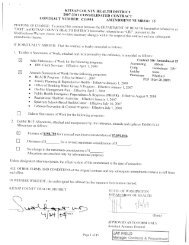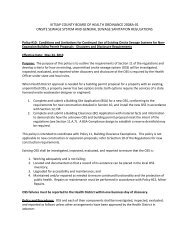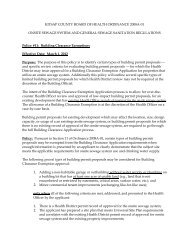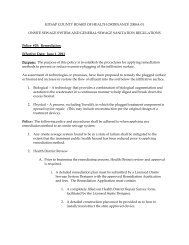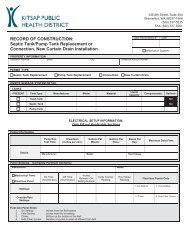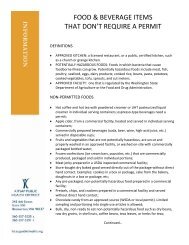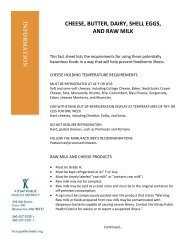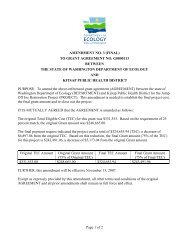SOLID WASTE REGULATIONS - Kitsap Public Health District
SOLID WASTE REGULATIONS - Kitsap Public Health District
SOLID WASTE REGULATIONS - Kitsap Public Health District
You also want an ePaper? Increase the reach of your titles
YUMPU automatically turns print PDFs into web optimized ePapers that Google loves.
purpose of this section, ground water includes any water-bearing unit which is horizontally and<br />
vertically extensive, hydraulically recharged, and volumetrically significant.<br />
(b) The owner or operator of a tank used to store or treat liquid or semisolid wastes meeting the<br />
definition of solid waste or leachate, shall prepare engineering reports/plans and specifications,<br />
including a construction quality assurance plan, to address the following design standards:<br />
(i) Tanks and ancillary equipment shall be tested for tightness using a method acceptable to the<br />
jurisdictional health department prior to being covered, enclosed or placed in use. If a tank is found not<br />
to be tight, all repairs necessary to remedy the leak(s) in the system shall be performed and verified to<br />
the satisfaction of the jurisdictional health department prior to the tank being covered or placed in use.<br />
(ii) Below ground tanks and other tanks where all or portions of the tank are not readily visible shall<br />
be designed to resist buoyant forces in areas of high ground water and shall either be:<br />
(A) Retested for tightness at a minimum of once every two years; or<br />
(B) Equipped with a leak detection system capable of detecting a release from the tank;<br />
(iii) For tanks or components in which the external shell of a metal tank or any metal component will<br />
be in contact with the soil or water, a determination shall be made by a corrosion expert of the type and<br />
degree of external corrosion protection that is needed to ensure the integrity of the tank during its<br />
operating life. This determination shall be included with design information submitted with the permit<br />
application;<br />
(iv) Above ground tanks shall be equipped with secondary containment constructed of, or lined with,<br />
materials compatible with the waste being stored and capable of containing the volume of the largest<br />
tank within its boundary plus the precipitation from the twenty-five-year storm event as defined in<br />
WAC 173-350-100;<br />
(v) Areas used to load or unload tanks shall be designed to contain spills, drippage and accidental<br />
releases during loading and unloading of vessels;<br />
(vi) Tanks and piping shall be protected from impact by vehicles or equipment through use of<br />
curbing, grade separation, bollards or other appropriate means;<br />
(vii) Tanks shall be structurally suited for the proposed use; and<br />
(viii) Tanks, valves, fittings and ancillary piping shall be protected from failure caused by freezing.<br />
(4) Surface impoundments and tanks - Operating standards. The owner or operator of a surface<br />
impoundment or tank shall:<br />
(a) Operate the facility to:<br />
(i) Prevent overfilling of surface impoundments or tanks and maintain required freeboard;<br />
(ii) Control access to the site;<br />
(iii) Control nuisance odors for wastes or liquids with the potential to create nuisance odors; and<br />
(iv) Control birds at impoundments storing wastes capable of attracting birds.<br />
(b) Inspect surface impoundments, tanks and associated piping, pumps and hoses as needed, but at<br />
least weekly, to ensure they are meeting the operational standards, unless an alternate schedule is<br />
approved by the jurisdictional health department as part of the permitting process. In addition, surface<br />
impoundments shall have regular liner inspections. Their frequency and methods of inspection shall be<br />
specified in the plan of operation and shall be based on the type of liner, expected service life of the<br />
material, and the site-specific service conditions. The inspections shall be conducted at least once every<br />
five years, unless an alternate schedule is approved by the jurisdictional health department as part of the<br />
permitting process. The jurisdictional health department shall be given sufficient notice and have the<br />
opportunity to be present during liner inspections.<br />
(c) Maintain daily operating records on the quantity and the types of waste removed from the surface<br />
impoundment or tank. Facility inspection reports shall be maintained in the operating record. Significant<br />
deviations from the plan of operation shall be noted in the operating record. Records shall be kept for a<br />
minimum of five years and shall be available for inspection upon request by the jurisdictional health<br />
department.<br />
(d) Shall prepare and submit a copy of an annual report to the jurisdictional health department and<br />
the department by April 1st. The annual report shall detail the facility's activities during the previous<br />
KCBH ORDINANCE 2010-1 51 <strong>SOLID</strong> <strong>WASTE</strong> <strong>REGULATIONS</strong>



